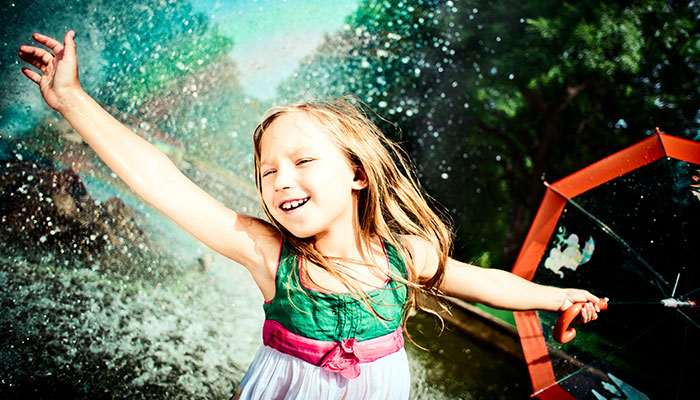While we believe that the books and resources recommended may be of value to you, keep in mind that these are suggestions only and you must do your own due diligence to determine whether the materials are appropriate and suitable for your use. PNC has no sponsorship or endorsement agreement with the authors or publishers of the materials listed.
OUR SKY

Catching Rainbows
Children will investigate rainbows.

Lesson Objective
Children will investigate how rainbows appear, their colors, and make a rainbow in the classroom.
ScienceArt
What You'll Need
- Medium-sized clear glass jars – 1 per child
- Water – enough to fill each jar
- Windowsill
- Bright sunlight
- Large sheet of white butcher paper
- Rainbow-colored watercolor paints, markers, or crayons – 1 set per 2 children
What To Do
Note: Try to plan this activity for a bright, sunny day.
- Discuss rainbows with the children (see Guiding Student Inquiry).
- Tell the children they are going to make a rainbow in the classroom with water and light.
- Fill the jars with water to the top.
- Set the jars on the windowsill in bright sunlight. (Note: The jars should stick out over the edge just a little bit.)
- Place the white butcher paper on the floor in front of the window—use a large piece of paper to allow more space for the children to work.
- A rainbow will be “captured” (projected) onto the paper. This will depend on how bright the Sun is shining through the window and the position of the glass jar. You may have to move the jar from side to side on the windowsill until you see the rainbow reflected on the paper.
- Discuss what is happening (see Did You Know?), and have the children name the colors of the rainbow: red, orange, yellow, green, blue, indigo, violet.
- Explain that sunlight contains all of these colors mixed together, but when the sunlight hits water, all of the colors are separated, creating a rainbow. Continue by explaining that the colors in the rainbow always appear in the same order.
- Allow the children to paint the colors directly onto the paper on the floor as the rainbow is reflected there.
Resources
Home School Resources
Home educators: use these printable lesson PDFs to teach this lesson to your home schoolers. They're available in English and Spanish.
Content Provided By
Common Core State Standards Initiative – These lessons are aligned with the Common Core State Standards ("CCSS"). The CCSS provide a consistent, clear understanding of the concepts and skills children are expected to learn and guide teachers to provide their students with opportunities to gain these important skills and foundational knowledge [1]. Visit the CCSS


